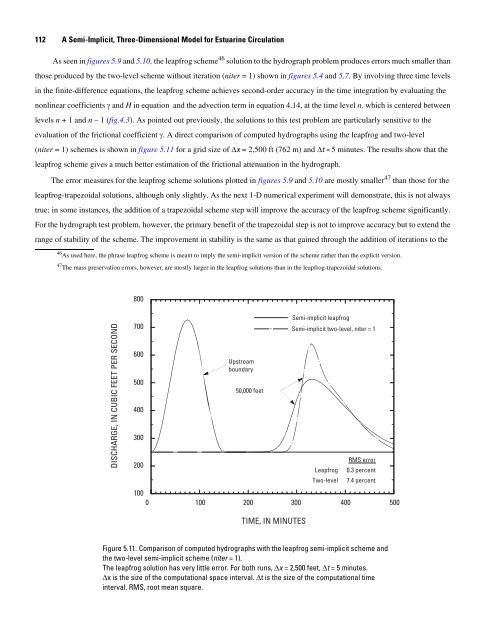A Semi-Implicit, Three-Dimensional Model for Estuarine ... - USGS
A Semi-Implicit, Three-Dimensional Model for Estuarine ... - USGS
A Semi-Implicit, Three-Dimensional Model for Estuarine ... - USGS
You also want an ePaper? Increase the reach of your titles
YUMPU automatically turns print PDFs into web optimized ePapers that Google loves.
112 A <strong>Semi</strong>-<strong>Implicit</strong>, <strong>Three</strong>-<strong>Dimensional</strong> <strong>Model</strong> <strong>for</strong> <strong>Estuarine</strong> Circulation<br />
As seen in figures 5.9 and 5.10, the leapfrog scheme 46 solution to the hydrograph problem produces errors much smaller than<br />
those produced by the two-level scheme without iteration (niter = 1) shown in figures 5.4 and 5.7. By involving three time levels<br />
in the finite-difference equations, the leapfrog scheme achieves second-order accuracy in the time integration by evaluating the<br />
nonlinear coefficients γ and H in equation and the advection term in equation 4.14, at the time level n, which is centered between<br />
levels n + 1 and n – 1 (fig.4.3). As pointed out previously, the solutions to this test problem are particularly sensitive to the<br />
evaluation of the frictional coefficient γ. A direct comparison of computed hydrographs using the leapfrog and two-level<br />
(niter = 1) schemes is shown in figure 5.11 <strong>for</strong> a grid size of Δx = 2,500 ft (762 m) and Δt = 5 minutes. The results show that the<br />
leapfrog scheme gives a much better estimation of the frictional attenuation in the hydrograph.<br />
The error measures <strong>for</strong> the leapfrog scheme solutions plotted in figures 5.9 and 5.10 are mostly smaller 47 than those <strong>for</strong> the<br />
leapfrog-trapezoidal solutions, although only slightly. As the next 1-D numerical experiment will demonstrate, this is not always<br />
true; in some instances, the addition of a trapezoidal scheme step will improve the accuracy of the leapfrog scheme significantly.<br />
For the hydrograph test problem, however, the primary benefit of the trapezoidal step is not to improve accuracy but to extend the<br />
range of stability of the scheme. The improvement in stability is the same as that gained through the addition of iterations to the<br />
46 As used here, the phrase leapfrog scheme is meant to imply the semi-implicit version of the scheme rather than the explicit version.<br />
47 The mass preservation errors, however, are mostly larger in the leapfrog solutions than in the leapfrog-trapezoidal solutions.<br />
DISCHARGE, IN CUBIC FEET PER SECOND<br />
800<br />
700<br />
600<br />
500<br />
400<br />
300<br />
200<br />
Upstream<br />
boundary<br />
50,000 feet<br />
<strong>Semi</strong>-implicit leapfrog<br />
<strong>Semi</strong>-implicit two-level, niter = 1<br />
RMS error<br />
Leapfrog 0.3 percent<br />
Two-level 7.4 percent<br />
100<br />
0 100 200 300 400 500<br />
TIME, IN MINUTES<br />
Figure 5.11. Comparison of computed hydrographs with the leapfrog semi-implicit scheme and<br />
the two-level semi-implicit scheme (niter = 1).<br />
The leapfrog solution has very little error. For both runs, Δx = 2,500 feet, Δt = 5 minutes.<br />
Δx is the size of the computational space interval. Δt is the size of the computational time<br />
interval. RMS, root mean square.

















